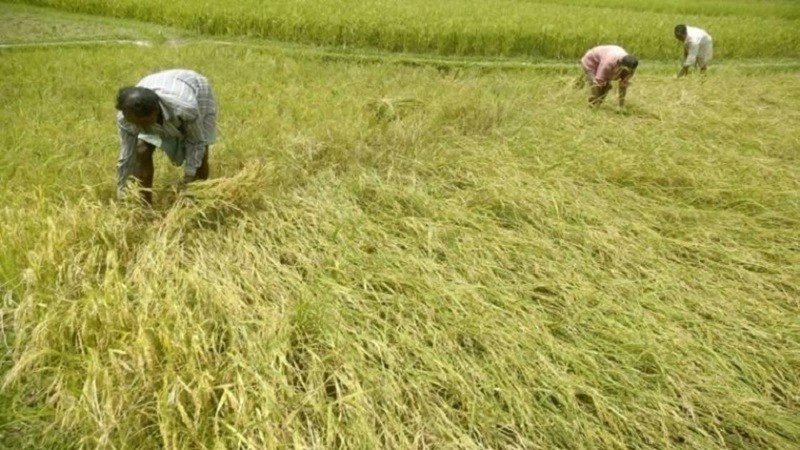Lucknow, December 3: To ensure economic stability for farmers and provide a fair evaluation of their efforts, the Yogi government in Uttar Pradesh is utilising scientific and technical methods to assess the productivity of Kharif crops.
Under the Pradhan Mantri Fasal Bima Yojana (PMFBY), the state utilizes modern technologies, including crop-cutting experiments (CCE), to accurately measure crop productivity, assess potential damages, and deliver timely insurance benefits to farmers.
In the current Kharif season, a target of over 3 lakh crop-cutting experiments has been set using the CCE Agri App, with 2.45 lakh experiments already completed. This marks a significant step towards ensuring transparency and accuracy in agricultural production assessments.
Additionally, 11,374 crop-cutting experiments have been completed through the GCES App, against a target of 13,654. These initiatives not only evaluate crop productivity but also ensure that farmers receive timely and accurate compensation under the crop insurance scheme.
Modern technologies empowering farmers for accurate assessments
State-of-the-art tools like CCE Agri App and GCES App are revolutionizing the crop harvesting process, making it faster and more efficient. These advanced technologies provide precise data on crop conditions, production capacity, and potential damage, enabling insurance companies to process accurate information and ensure timely compensation for farmers.
This Kharif season, the scheme covers 10 crops, including paddy, maize, millet, sorghum, urad, moong, sesame, peanuts, soybean, and pigeon pea. Productivity for these crops is being accurately assessed through crop-cutting experiments. This initiative not only helps farmers become self-reliant but also positions the state as a leader in agricultural advancements.
Crop-cutting experiments ensure fair compensation for farmers
Crop-cutting experiments play a vital role in determining compensation for farmers facing crop losses. By calculating the average yield, these experiments help generate district-level agricultural production data, which is then submitted to the government. Based on this data, farmers with crop insurance receive compensation for their losses. The Agriculture Department compiles average yield data from all districts to determine the per-hectare productivity of various crops.
To ensure accuracy, the Yogi government has appointed officials from the Agriculture, Revenue, and Development Departments to conduct mandatory inspections of 15% of the experiments in each district. Additionally, representatives from empanelled insurance companies co-observe 30% of the crop-cutting experiments under the Pradhan Mantri Fasal Bima Yojana, further ensuring transparency and reliability in the process.
The government compensates affected farmers under PMFBY based on data gathered through crop-cutting experiments. Under this scheme, farmers receive compensation from the respective insurance companies in cases of crop damage. CM Yogi has highlighted the importance of effectively implementing these initiatives to ensure transparency in the agriculture sector and boost farmers’ incomes.
Crop-cutting experiments prove to be a boon for farmers
In a state where a significant portion of the population relies on agriculture, the Yogi government is taking proactive steps to shield farmers from financial crisis caused by crop damage. As part of these efforts, employees from relevant departments conduct crop-cutting experiments by harvesting and weighing grain from a 10-meter side of an equilateral triangle within randomly selected village fields. These experiments are reviewed by Sub-Divisional Magistrates and Tehsildars to ensure accuracy.
This extensive network of crop-cutting experiments not only provides much-needed relief to farmers but also contributes to enhancing agricultural productivity and ensuring the effective implementation of government schemes.
Yogi government ensures widespread participation of farmers in schemes
The Yogi government, in alignment with the Central Government’s focus on public welfare and farmer-centric schemes, has improved coordination between farmers, the agriculture department, and insurance companies. Crop production and loss data, once confined to paper processes, is now digitized, making it easier to implement schemes on time.
Traditionally, Crop Cutting Experiments (CCE) relied on the yield component method, where specific locations were selected through random sampling of the total area under study. Once plots were chosen, produce was harvested and analyzed for various parameters like biomass weight, grain weight, moisture, and other indicators. The data collected is then extrapolated to provide accurate estimates for the entire region.
This model does not provide an exact assessment of the average yield for the state or region but offers an approximate estimate for the area under study.
The system of assessing agricultural productivity is fostering greater trust between farmers and insurance companies. Moving forward, the Uttar Pradesh government plans to strengthen this model and further promote technological advancements in agriculture. The successful implementation of farmer-friendly schemes is not only boosting the agricultural sector but also driving the state’s economic growth.
